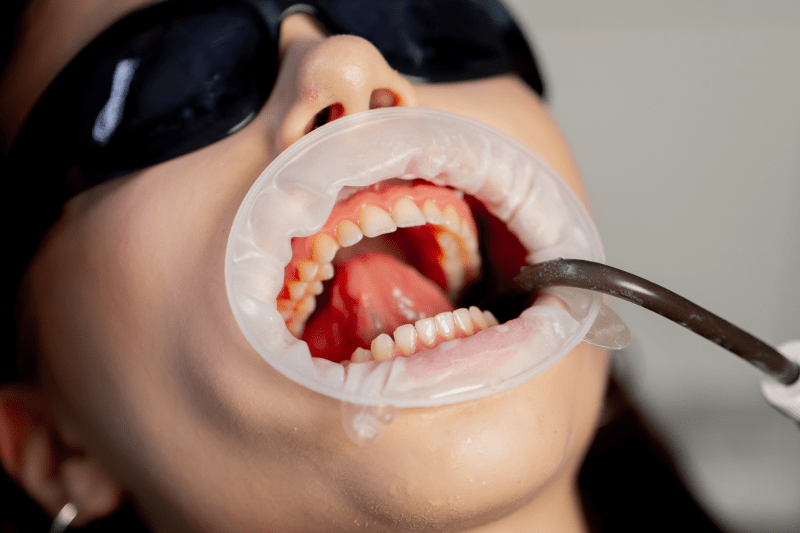Dental Veneers vs. Laminate Veneers: Which One is Better?
Among the most popular options for aesthetic dental treatments today, dental veneers and laminate veneers offer excellent solutions for transforming your smile. However, the differences between these two treatments and which one is more suitable for certain situations can be confusing. This content answers frequently asked questions by providing a comparative analysis of the pros and cons of both methods. This will help you make the best decision for your expectations and budget. For more information and to create a personalized treatment plan, you can contact Cure Holiday.
What are Dental Veneers and Laminate Veneers?
Although the terms dental veneers and laminate veneers are often used interchangeably, there are some important differences between them. Both are thin layers bonded to the front surface of the teeth, aiming to improve their shape, color, and size. However, laminate veneers are notable for their thinner structure and require minimal tooth reduction. Dental veneers, on the other hand, can be thicker and are used for more comprehensive aesthetic adjustments. Both can be made from porcelain or composite materials.
What are the Key Differences Between the Two Treatments?
The main difference between dental veneers and laminate veneers is their thickness and, consequently, the amount of tooth reduction required. Laminate veneers, being much thinner, can be applied with almost no tooth reduction. This allows for maximum preservation of the natural tooth structure. The thicker dental veneers, however, may require more tooth reduction on the front surface to ensure a perfect fit and a natural-looking result, especially for larger shape or color imperfections. This difference also determines whether the treatment is reversible.
Which Treatment Preserves the Natural Tooth Structure More?
Laminate veneers are the treatment method that preserves the natural tooth structure the most. In most cases, very little to no tooth enamel is removed for the application of laminate veneers. This means that even when a patient decides on this treatment, their tooth’s original structure remains largely intact. Dental veneers are thicker, so they may require more tooth reduction to sit properly on the tooth and provide a natural appearance.
Which Treatment is More Durable and Long-Lasting?
Generally, dental veneers are more durable and long-lasting than laminate veneers. Porcelain dental veneers can last up to 15-20 years with proper care. Laminate veneers, due to their thin structure, can be slightly more fragile against chipping, and their lifespan is around 10-15 years. However, the longevity of both treatments depends on oral hygiene, eating habits, and factors like teeth grinding.
How Do Composite and Porcelain Materials Affect These Treatments?
Both dental veneers and laminate veneers can be made from porcelain or composite materials. Porcelain is more durable, stain-resistant, and reflects light like a natural tooth compared to composite. These properties make porcelain veneers more long-lasting and aesthetically pleasing. Composite, while being more affordable and applicable in a single session, can stain more easily and may lose its shine over time.
Which Treatment Offers a More Natural Appearance?
When applied correctly, both treatments can provide a very natural appearance, but laminate veneers, with their thin structure, better mimic the translucency of natural tooth enamel. This gives them a slightly superior natural look. Dental veneers, being thicker, allow for more dramatic changes in color and shape. Ultimately, your aesthetic expectations, the condition of your teeth, and the dentist’s experience are the decisive factors.
Which Treatment Can Fix More Serious Dental Problems?
If your teeth have significant discoloration, large gaps, or noticeable misalignment, dental veneers might be a more suitable solution. Their thicker structure effectively covers such imperfections. Laminate veneers are preferred for more minimal aesthetic issues like minor discoloration, small chips, and slight gaps between teeth. For severe alignment problems, orthodontic treatment might be necessary first.

Which Treatment Provides Quicker Results?
If composite material is chosen, both dental veneers and laminate veneers can be completed in a single appointment, providing quick results. However, the porcelain process requires laboratory work, which extends the treatment time. In this case, composite dental veneers or composite laminate veneers are the quickest options. Porcelain veneers are usually completed within a few days to a week.
Which One is More Cost-Effective?
From a pricing perspective, laminate veneers are generally more affordable than dental veneers. This is mainly because they use less material and in some cases require less laboratory time. However, the veneer material (porcelain vs. composite) and the number of teeth to be treated significantly affect the total cost. Composite veneers are the most economical option.
Which Treatment is More Resistant to Chipping?
In general, dental veneers are more resistant to chipping than laminate veneers because they are thicker and stronger. Porcelain dental veneers, in particular, have high resistance to chewing forces. However, both types of veneers can be affected by biting hard objects or teeth grinding.
Is the Treatment Reversible?
Laminate veneers, requiring minimal tooth reduction, are potentially more reversible. Dental veneers, which involve removing more tooth enamel, are considered an irreversible treatment. Therefore, it is crucial to carefully consider this decision and have a detailed discussion with a dentist before starting the treatment.
Do Teeth Become Sensitive After the Treatment?
It is normal to experience temporary sensitivity after both treatments, especially if tooth reduction was performed. This sensitivity is usually to hot and cold foods and drinks and subsides within a few days. If the sensitivity persists, you can use special toothpastes or medications as recommended by your dentist.
Which Veneer is Suitable for People with Teeth Grinding Issues?
For people with teeth grinding (bruxism), dental veneers are a more suitable option due to their thicker and stronger structure. Veneers made from durable materials like zirconia are more resistant to the wear caused by this condition. Your dentist may also recommend additional measures, such as a night guard, to protect your veneers.
What is the Long-Term Cost of the Treatment?
While composite veneers have a lower initial cost, their shorter lifespan means they may require frequent repairs or replacement, which can increase the long-term cost. Laminate veneers or dental veneers made from porcelain or zirconia have a higher initial investment but can be a more economical solution in the long run due to their longer lifespan.
How Long Does the Treatment Process Take?
Composite veneers are generally completed in a single session. Veneers made from materials like porcelain or zirconia require a laboratory process, which may necessitate multiple appointments and a travel period of 5-7 days. This time frame covers the initial consultation, tooth preparation, fitting, and final bonding.
Which Treatment Covers Stains Better?
Dental veneers and laminate veneers, when made from materials like porcelain and zirconia, can completely cover permanent stains and discoloration. The high opacity and stain resistance of porcelain are extremely effective in addressing this issue. Composite veneers are suitable for lighter stains but may change color over time.
Does Getting Veneers Affect My Gum Health?
When applied correctly, both dental veneers and laminate veneers do not negatively affect gum health. A procedure performed with biocompatible materials and without harming the gums does not increase the risk of gingivitis. On the contrary, by eliminating surface irregularities, it can make oral hygiene easier.
What Expertise is Required for the Treatment?
Veneer treatment should be performed by a dentist specializing in aesthetic dentistry and prosthodontics. An experienced dentist can correctly analyze your tooth structure and create the most suitable treatment plan to meet your aesthetic expectations.
What Should I Do After the Treatment?
To extend the life of your veneers, you should maintain good oral hygiene, avoid biting hard foods, and not miss your regular dental checkups. If you have a teeth grinding habit, using a night guard is recommended.
Are Dental Veneers and Laminate Veneers the Same Thing?
No, they are not technically the same. “Veneer” is a broader term that describes aesthetic applications covering the front surface of a tooth. “Laminate veneer” is a specific type of this application, referring to ultra-thin porcelain veneers. These veneers require less tooth reduction and can be considered a sub-type of porcelain veneers.
Do Veneers Cover Tooth Decay?
Veneers are not a solution for treating tooth decay. If you have a cavity, it must be cleaned and filled before the veneer is placed. Veneers are only used to fix aesthetic problems.
How Long Should I Set Aside to Travel to Turkey for Veneers?
For dental or laminate veneers made from materials like porcelain or zirconia, a travel plan of 5 to 7 days is usually sufficient. This period covers the entire process from the initial consultation to the final bonding of the veneers.
In Which Cases are Composite Veneers Not Recommended?
Composite veneers are not recommended for major aesthetic problems like severe teeth misalignment, large gaps, or heavy discoloration. Additionally, they may have durability issues in people with teeth grinding habits or in back teeth where chewing forces are high.
What is the Difference Between Zirconia Veneers and Laminate Veneers?
Zirconia veneers cover the entire tooth and have a much more durable structure. Laminate veneers only cover the front surface of the tooth and are used primarily for aesthetic purposes. Zirconia stands out for its strength, while laminate veneers offer a more natural appearance.

Which Treatment Makes My Teeth Shine More?
Veneers made from materials like porcelain and zirconia have smooth surfaces that mimic the shine of natural tooth enamel. This gives them a long-lasting and dazzling brightness. Composite veneers can also be polished but may become dull over time.
What is Included in the Prices?
The prices for veneers in Turkey usually include the dentist’s examination, panoramic X-ray, tooth preparation, temporary veneers, and the placement of the final veneers. Some clinics offer all-inclusive packages that also cover accommodation and transfer services.
In Which Case Should Laminate Veneers be Preferred?
If your teeth have mild discoloration, small chips, or minimal gaps, and you want to preserve the natural tooth structure with minimal intervention, laminate veneers are an excellent option. They are also ideal for those looking for a quick and relatively affordable solution.
In Which Case Should Dental Veneers be Preferred?
If you need more comprehensive aesthetic adjustments and your teeth have more pronounced shape imperfections, discoloration, or larger gaps, dental veneers might be more suitable. Their thicker structure can fix such issues more effectively and provides a stronger restoration.
Am I a Suitable Candidate for Veneers?
To determine if you are a suitable candidate, you need to consult a dentist. The dentist will check the health of your teeth and gums, listen to your expectations, and determine which treatment is best for you.
Can I Whiten My Teeth After Getting Veneers?
The color of your veneers is permanent and will not change with whitening. If you want to whiten your teeth, you should do so before the veneer procedure. This way, the color of the veneers will be chosen to match your whitened teeth for a more harmonious result.
Will My Teeth Be Reduced Significantly?
For laminate veneers, your teeth are reduced very little, while for dental veneers, this amount may be slightly more. However, in both procedures, the main goal is to preserve the natural tooth structure. Your dentist will aim to achieve the best result with the least amount of reduction.
How Long Can I Use My Veneers?
The lifespan of veneers depends on the material used and your personal care. Porcelain and zirconia veneers can last 10-20 years, while composite veneers may need replacement after 5-7 years. With regular dental care and checkups, the lifespan of your veneers can be extended.
Are There Risks with Both Treatments?
As with any surgical or aesthetic procedure, there are some risks with veneers. These include sensitivity, chipping, or the veneer coming off. To minimize these risks, it is important to choose an experienced dentist and follow all instructions.
Can I Eat Normally with Veneers?
Yes, you can eat normally with veneers. Veneers are designed to perform the same functions as your natural teeth. However, it is recommended to avoid biting very hard foods like nuts with your front teeth or putting excessive pressure on your veneers.
Are Dental Veneers and Laminate Veneers Cared for the Same Way?
Yes, both types of veneers are cared for in the same way. Regular brushing, flossing, and periodic dental checkups are sufficient to maintain your veneers and oral health.
For more information about dental veneers and laminate veneers options in Turkey and to create a personalized treatment plan, you can contact Cure Holiday.



